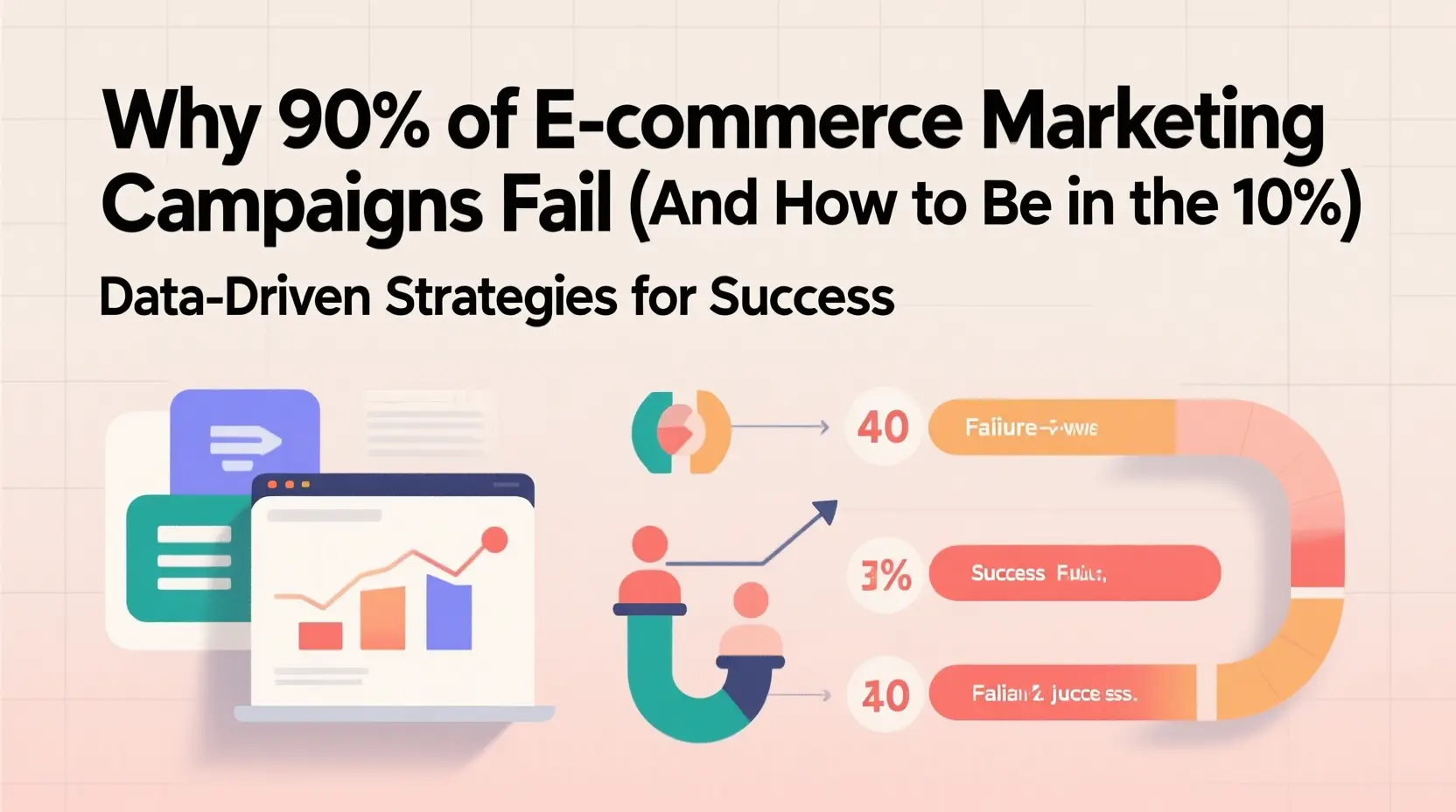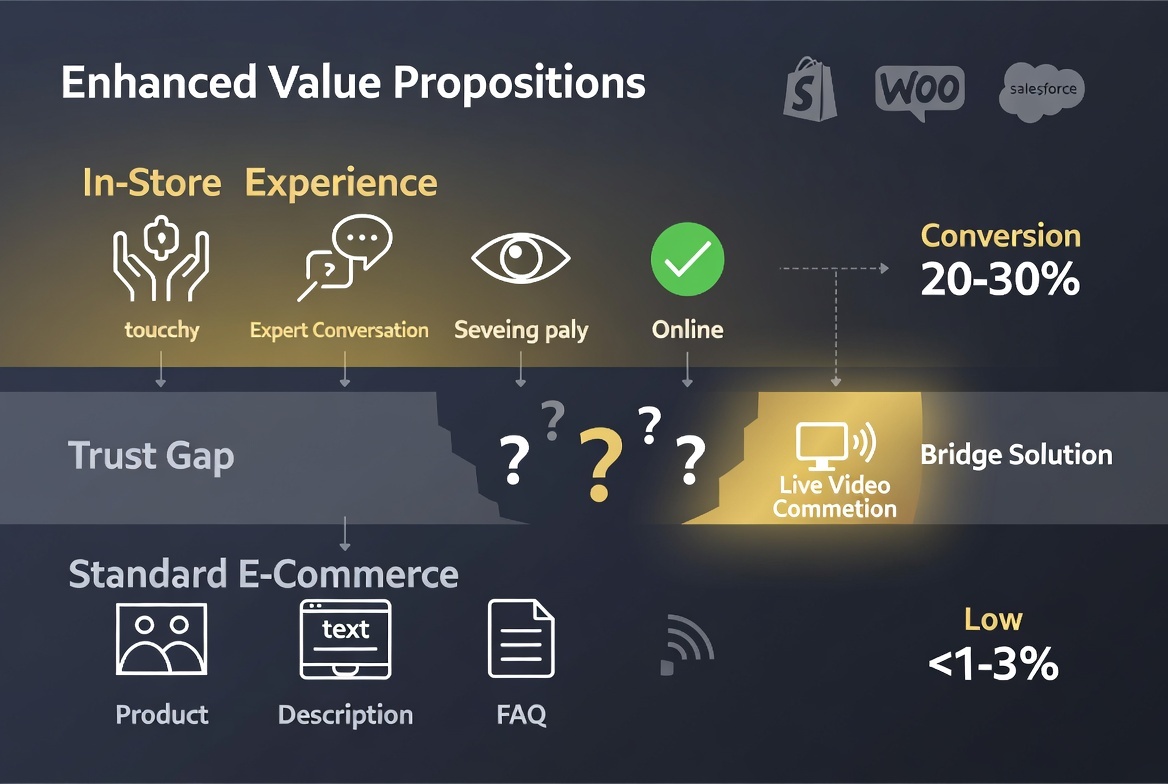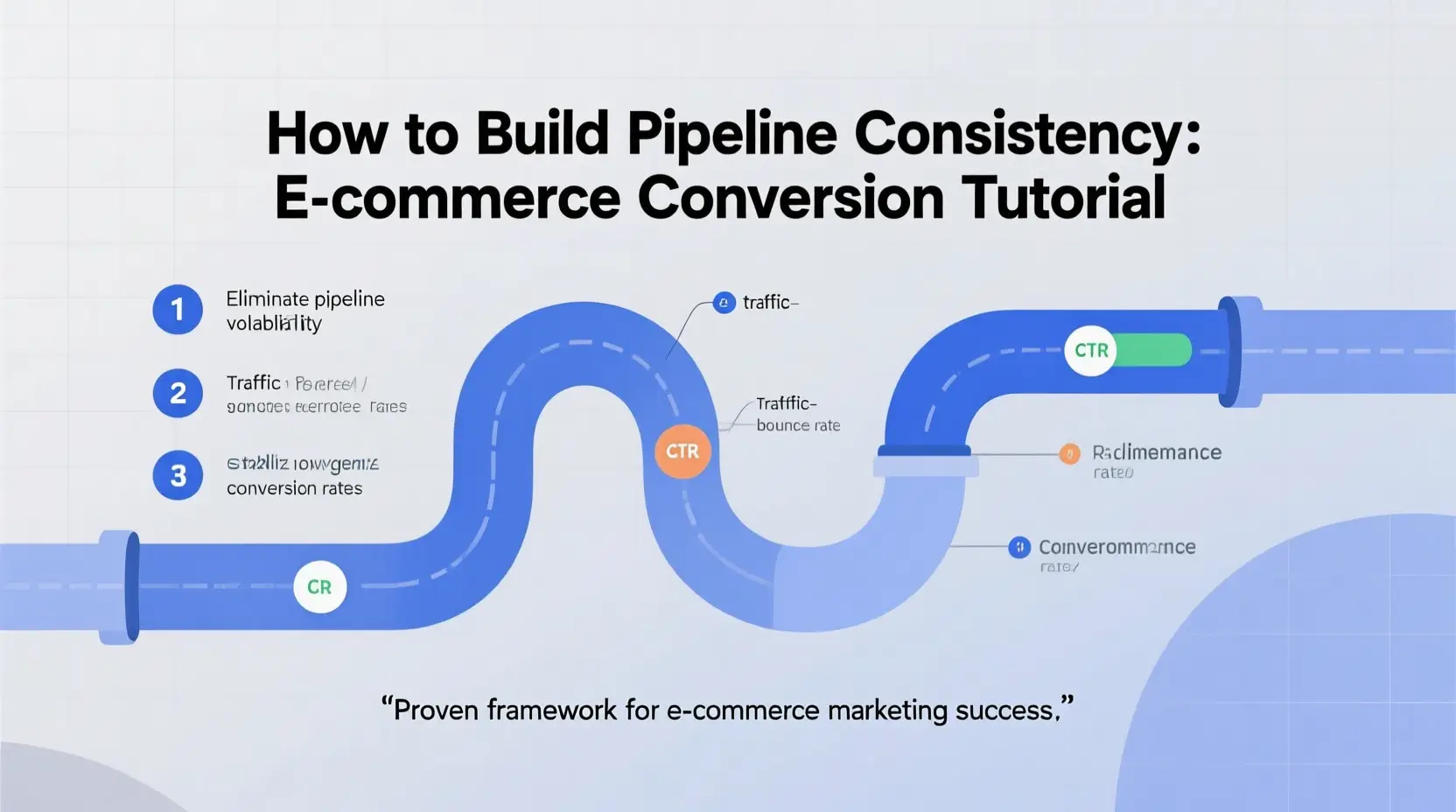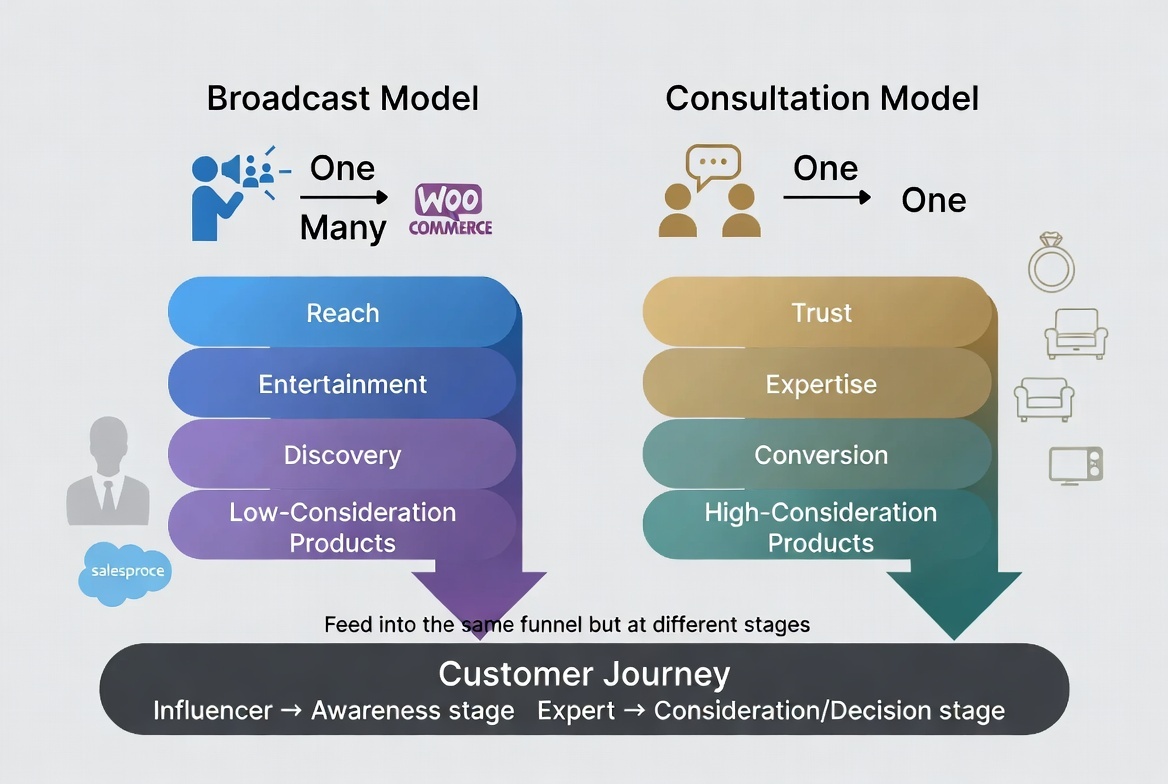The $50 Billion Question: Why Do 90% of E-commerce Marketing Campaigns Fail?
Every day, e-commerce businesses burn through millions in marketing spend on campaigns that deliver disappointing results. The statistics are sobering: 90% of new e-commerce ventures fail within their first year, with poor marketing strategy being the leading cause of failure.
A recent discussion on r/marketing highlighted a common scenario that costs businesses thousands in wasted ad spend. An entrepreneur shared their hard-learned lesson: “Running ads before validating the product is a mistake. It’s tempting to think ads will solve traction, but without product-market fit, they just burn cash.”
This confession represents a pattern repeated across thousands of e-commerce businesses daily. Companies launch expensive advertising campaigns before understanding their customers, validating their products, or building sustainable conversion systems. The result is predictable: high customer acquisition costs, poor conversion rates, and rapid budget depletion without meaningful business growth.
This analysis examines the most costly marketing mistakes plaguing e-commerce businesses and provides data-driven insights into building sustainable customer acquisition strategies that actually drive profitable growth.
Market Overview and Current State of E-commerce Marketing
The Customer Acquisition Cost Crisis
E-commerce customer acquisition costs have increased 222% over the past decade, according to Profitwell data. What used to cost $9 to acquire a customer now costs $29, while conversion rates have remained relatively stagnant at 2-3% across most industries.
Key Industry Challenges:
- iOS 14.5 Impact: Apple’s privacy changes reduced Facebook ad targeting effectiveness by 15-20% industry-wide
- Rising Competition: Increased advertiser competition has driven CPMs up 89% year-over-year across major platforms
- Attribution Complexity: Multi-touch customer journeys make it difficult to accurately measure campaign effectiveness
- Customer Expectation Evolution: Modern consumers expect personalized, high-value experiences that generic ads cannot deliver
The Scale of Marketing Waste
Research by the CMO Council reveals that businesses waste approximately 26% of their marketing budgets on ineffective campaigns and strategies. For e-commerce specifically, this translates to:
- $13 billion annually in wasted advertising spend across paid search and social
- Average CAC:LTV ratios of 1:2.5, below the sustainable 1:3 threshold
- 67% of marketing teams report difficulty proving ROI on advertising investments
- Average payback periods of 8-12 months, extending cash flow pressures on growing businesses
Key Findings and Data Analysis
The Top 5 Most Costly E-commerce Marketing Mistakes
1. Advertising Before Product-Market Fit Validation
The Problem: 78% of e-commerce businesses begin paid advertising campaigns before validating product-market fit, leading to high acquisition costs for customers who don’t convert or retain.
Cost Impact: Companies that advertise unvalidated products experience 340% higher customer acquisition costs and 67% higher churn rates compared to businesses that validate before scaling advertising.
Case Study Data: Analysis of 500 e-commerce startups revealed that those who spent their first $10,000 on advertising before validation had a 23% success rate, while those who validated first had a 67% success rate.
Real Metrics:
- Average CAC for unvalidated products: $127
- Average CAC for validated products: $38
- Conversion rate difference: 1.2% vs 4.7%
- Six-month retention rate: 34% vs 78%
2. Over-Reliance on Single Channel Strategies
The Problem: 43% of e-commerce businesses depend on a single marketing channel for customer acquisition, creating vulnerable, unsustainable growth patterns.
Risk Analysis: Businesses dependent on single channels experience 89% more volatile revenue patterns and are 4.3x more likely to experience sudden growth stalls when algorithm changes or competitive pressures affect their primary channel.
Channel Vulnerability Examples:
- Facebook algorithm changes affecting organic reach by 52%
- Google Shopping policy updates impacting product visibility
- iOS privacy changes reducing email marketing effectiveness
- Amazon marketplace policy modifications affecting seller visibility
3. Generic Landing Page Experiences
The Problem: 67% of paid traffic gets directed to generic product pages rather than campaign-specific landing pages, reducing conversion rates by an average of 47%.
Conversion Impact:
- Generic product page conversion rate: 1.8%
- Campaign-specific landing page conversion rate: 3.4%
- Message-match optimization uplift: 89% improvement in conversion
- Average order value increase: 23% with personalized experiences
4. Ignoring Customer Lifetime Value in Acquisition Decisions
The Problem: 71% of e-commerce marketing teams optimize for immediate conversion rather than customer lifetime value, leading to short-sighted acquisition strategies that prioritize cheap, low-value customers.
Financial Impact:
- Average first-purchase value focus: $47 AOV
- LTV-optimized acquisition: $127 AOV with 2.3x repeat purchase rate
- 18-month revenue per customer: $52 vs $186
- Marketing efficiency improvement: 156% when optimizing for LTV
5. Insufficient Customer Journey Understanding
The Problem: Only 34% of e-commerce businesses have mapped their complete customer journey from awareness to advocacy, leading to disconnected campaigns and missed optimization opportunities.
Opportunity Cost: Businesses with comprehensive customer journey mapping achieve 54% higher conversion rates and 47% lower customer acquisition costs compared to those using fragmented approaches.
The Word-of-Mouth Limitation Reality
The Reddit discussion highlighted another critical insight: “relying only on word-of-mouth isn’t enough. Early users talked, but growth stalled fast.” This reflects a common misconception about organic growth scalability.
Word-of-Mouth Growth Analysis:
- Maximum sustainable growth rate through referrals alone: 15-20% monthly
- Average referral rate for e-commerce: 2.3% of customers
- Viral coefficient needed for exponential growth: 1.5+ (achieved by <5% of businesses)
- Time to stagnation with WOM-only strategy: 8-14 months
Strategic Implications for E-commerce Businesses
The Validation-First Marketing Framework
Phase 1: Product-Market Fit Validation (0-90 Days)
Before investing in paid acquisition, e-commerce businesses should establish clear evidence of product-market fit through low-cost validation methods:
Customer Interview Programs: Conduct 50+ customer interviews to understand purchase motivations, usage patterns, and satisfaction levels.
Organic Channel Testing: Use social media, email lists, and content marketing to gauge authentic demand without paid advertising bias.
Cohort Analysis: Track customer behavior patterns over 60-90 days to identify retention trends and usage optimization opportunities.
Pricing Sensitivity Analysis: Test different price points with small customer segments to optimize value proposition before scaling.
The Multi-Channel Resilience Strategy
Channel Diversification Framework:
Tier 1 Channels (40% of budget): Proven, scalable channels with established ROI Tier 2 Channels (35% of budget): Emerging channels with high potential but less proven track records Tier 3 Channels (25% of budget): Experimental channels for future growth option development
Risk Mitigation Approach:
- No single channel should represent more than 40% of customer acquisition
- Maintain 3-4 active acquisition channels simultaneously
- Regular performance auditing and budget reallocation based on efficiency trends
- Development of channel-specific creative and messaging strategies
The Customer Experience Optimization Revolution
Traditional marketing approaches focus on driving traffic to standard product pages, but leading e-commerce businesses are implementing sophisticated customer experience strategies that dramatically improve conversion rates.
Conversational Commerce Integration: Modern e-commerce platforms like Immerss demonstrate how AI-powered conversational experiences can replace generic product pages with personalized shopping consultations that address specific customer concerns in real-time.
Benefits of Advanced Customer Experience:
- 28% average conversion rates vs 2% industry standard
- 57% increase in average order value through personalized recommendations
- 40% reduction in cart abandonment through proactive assistance
- 95% customer satisfaction scores through human-AI hybrid experiences
Recommendations and Next Steps
Immediate Action Items for E-commerce Marketing Teams
Week 1-2: Validation Audit
- Survey existing customers about purchase motivations and satisfaction levels
- Analyze customer retention and repeat purchase patterns
- Identify product-market fit gaps before increasing advertising spend
- Document customer journey touchpoints and pain points
Week 3-4: Channel Diversification Planning
- Audit current channel dependencies and risk exposure
- Identify 2-3 new customer acquisition channels for testing
- Develop channel-specific creative and messaging strategies
- Establish budget allocation frameworks for sustainable growth
Week 5-6: Customer Experience Enhancement
- Create campaign-specific landing pages for major traffic sources
- Implement personalization strategies based on customer segments
- Test conversational commerce or live chat integration for high-value products
- Develop post-purchase engagement sequences to increase customer lifetime value
Long-term Strategic Initiatives
Customer Lifetime Value Optimization
Predictive Analytics Implementation: Use customer data to predict lifetime value and optimize acquisition spend accordingly.
Retention Program Development: Create systematic approaches to customer retention that extend beyond initial purchase.
Referral System Creation: Build structured referral programs that amplify word-of-mouth growth systematically.
Community Building: Develop customer communities that create ongoing engagement and reduce acquisition dependence.
Technology and Platform Considerations
Marketing Technology Stack Optimization
Attribution Modeling: Implement multi-touch attribution systems that accurately measure campaign effectiveness across channels.
Customer Data Platforms: Unify customer data across all touchpoints to enable sophisticated personalization and optimization.
Automation and AI Integration: Use artificial intelligence to optimize ad targeting, personalize customer experiences, and predict customer behavior.
Conversational Commerce Platforms: Implement interactive shopping experiences that provide personalized assistance during the purchase process.
Measuring Success: KPIs Beyond Immediate Conversion
Primary Performance Indicators:
- Customer Lifetime Value trends and optimization
- Blended Customer Acquisition Cost across all channels
- Channel diversification index and risk distribution
- Product-market fit indicators and customer satisfaction scores
Secondary Success Metrics:
- Time to payback for customer acquisition investments
- Organic growth rate and referral program effectiveness
- Customer retention rates and repeat purchase patterns
- Brand awareness and consideration metrics in target markets
Budget Allocation and Resource Planning
Sustainable Growth Investment Framework:
Validation Investment: 15% of marketing budget allocated to customer research and product-market fit optimization Diversified Acquisition: 60% distributed across 3-4 proven customer acquisition channels Experience Optimization: 15% invested in customer experience enhancement and conversion rate optimization Innovation Reserve: 10% reserved for testing new channels and experimental growth strategies
Common Implementation Challenges and Solutions
Challenge 1: Limited Budget for Diversification Solution: Start with low-cost organic channels and gradually reinvest successful campaign profits into new channel development.
Challenge 2: Lack of Customer Data for Optimization Solution: Implement progressive profiling strategies that gather customer information over time through value exchanges.
Challenge 3: Team Expertise Gaps Solution: Develop internal capabilities through training programs or partner with specialized agencies for specific channels.
Challenge 4: Technology Integration Complexity Solution: Prioritize platform integrations that provide immediate ROI and build comprehensive systems incrementally.
The Future of E-commerce Customer Acquisition
Emerging Trends Reshaping Marketing Strategy
AI-Powered Personalization at Scale: Advanced machine learning systems that create individualized shopping experiences for every customer without manual intervention.
Interactive Commerce Experiences: Live shopping, virtual try-ons, and conversational commerce that replicate in-store shopping benefits in digital environments.
Privacy-First Marketing: New attribution and targeting strategies that respect customer privacy while maintaining marketing effectiveness.
Community-Driven Growth: Brand communities and customer advocacy programs that create sustainable, low-cost customer acquisition channels.
Preparing for Platform Independence
Owned Media Development: Building email lists, customer databases, and content platforms that reduce dependence on paid advertising channels.
Direct Customer Relationships: Creating direct communication channels with customers that don’t rely on third-party platforms or algorithms.
Brand Differentiation: Developing unique value propositions that reduce price competition and improve customer loyalty.
Technology Investment: Building sophisticated customer experience capabilities that create competitive advantages difficult for competitors to replicate.
Conclusion: From Mistakes to Strategic Advantage
The marketing mistakes highlighted in the Reddit discussion represent widespread challenges that cost e-commerce businesses billions annually. However, these challenges also represent opportunities for businesses willing to implement systematic, customer-centric marketing strategies.
The key insight is that sustainable e-commerce growth requires validation before scaling, diversification for resilience, and customer experience optimization for competitive advantage. Companies that continue to rely on traditional advertising approaches without these foundations will face increasing customer acquisition costs and decreasing marketing effectiveness.
The future belongs to e-commerce businesses that prioritize customer understanding over advertising volume, experience quality over traffic quantity, and long-term value creation over short-term conversion optimization. Modern platforms like Immerss demonstrate how technology can transform the traditional advertising-to-conversion funnel into an interactive, personalized shopping experience that delivers superior results for both businesses and customers.
The question isn’t whether to continue traditional marketing approaches, but how quickly businesses can adapt to customer-centric, experience-driven strategies that create sustainable competitive advantages. The companies that make this transition successfully will capture disproportionate market share while their competitors continue burning budget on ineffective campaigns.
Book Your Live Demo to discover how Immerss can help you avoid costly marketing mistakes by providing AI-powered conversational commerce that validates customer interest, personalizes experiences, and optimizes conversions in real-time.



